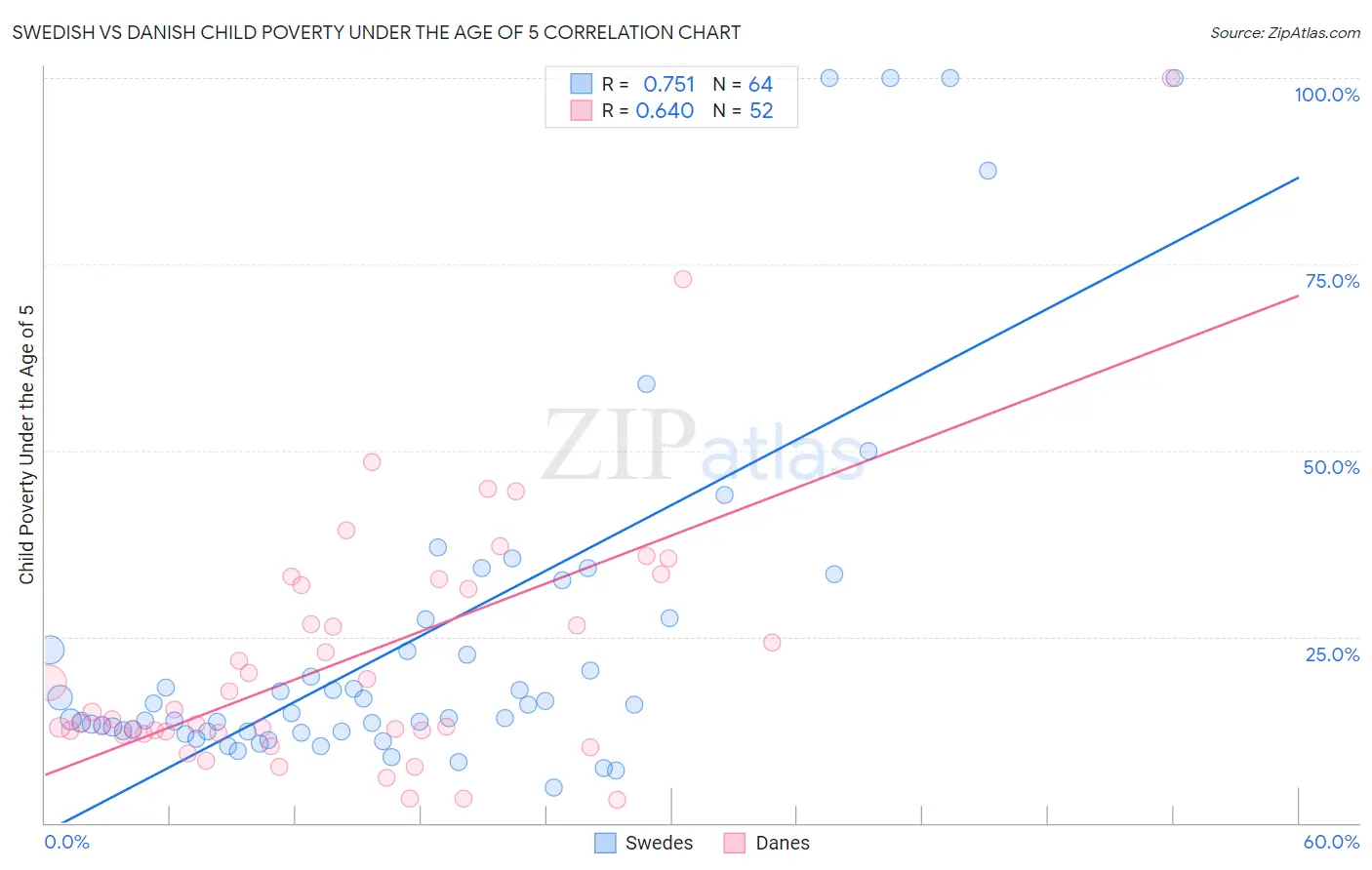Swedish vs Danish Child Poverty Under the Age of 5
COMPARE
Swedish
Danish
Child Poverty Under the Age of 5
Child Poverty Under the Age of 5 Comparison
Swedes
Danes
15.0%
CHILD POVERTY UNDER THE AGE OF 5
99.4/ 100
METRIC RATING
58th/ 347
METRIC RANK
14.9%
CHILD POVERTY UNDER THE AGE OF 5
99.4/ 100
METRIC RATING
55th/ 347
METRIC RANK
Swedish vs Danish Child Poverty Under the Age of 5 Correlation Chart
The statistical analysis conducted on geographies consisting of 502,877,472 people shows a strong positive correlation between the proportion of Swedes and poverty level among children under the age of 5 in the United States with a correlation coefficient (R) of 0.751 and weighted average of 15.0%. Similarly, the statistical analysis conducted on geographies consisting of 447,094,806 people shows a significant positive correlation between the proportion of Danes and poverty level among children under the age of 5 in the United States with a correlation coefficient (R) of 0.640 and weighted average of 14.9%, a difference of 0.20%.

Child Poverty Under the Age of 5 Correlation Summary
| Measurement | Swedish | Danish |
| Minimum | 4.8% | 3.2% |
| Maximum | 100.0% | 100.0% |
| Range | 95.2% | 96.8% |
| Mean | 24.6% | 22.1% |
| Median | 15.2% | 14.4% |
| Interquartile 25% (IQ1) | 12.3% | 12.2% |
| Interquartile 75% (IQ3) | 25.3% | 31.7% |
| Interquartile Range (IQR) | 13.0% | 19.5% |
| Standard Deviation (Sample) | 23.8% | 17.6% |
| Standard Deviation (Population) | 23.6% | 17.5% |
Demographics Similar to Swedes and Danes by Child Poverty Under the Age of 5
In terms of child poverty under the age of 5, the demographic groups most similar to Swedes are Egyptian (14.9%, a difference of 0.050%), Immigrants from Pakistan (14.9%, a difference of 0.13%), Paraguayan (15.0%, a difference of 0.15%), Immigrants from Russia (15.0%, a difference of 0.24%), and Immigrants from Israel (14.9%, a difference of 0.26%). Similarly, the demographic groups most similar to Danes are Immigrants from Israel (14.9%, a difference of 0.060%), Luxembourger (14.9%, a difference of 0.070%), Immigrants from Pakistan (14.9%, a difference of 0.070%), Egyptian (14.9%, a difference of 0.15%), and Immigrants from Serbia (14.9%, a difference of 0.23%).
| Demographics | Rating | Rank | Child Poverty Under the Age of 5 |
| Tsimshian | 99.6 /100 | #46 | Exceptional 14.7% |
| Russians | 99.6 /100 | #47 | Exceptional 14.8% |
| Immigrants | Czechoslovakia | 99.6 /100 | #48 | Exceptional 14.8% |
| Immigrants | Bulgaria | 99.6 /100 | #49 | Exceptional 14.8% |
| Immigrants | Northern Europe | 99.6 /100 | #50 | Exceptional 14.8% |
| Estonians | 99.6 /100 | #51 | Exceptional 14.8% |
| Immigrants | Serbia | 99.5 /100 | #52 | Exceptional 14.9% |
| Luxembourgers | 99.4 /100 | #53 | Exceptional 14.9% |
| Immigrants | Israel | 99.4 /100 | #54 | Exceptional 14.9% |
| Danes | 99.4 /100 | #55 | Exceptional 14.9% |
| Immigrants | Pakistan | 99.4 /100 | #56 | Exceptional 14.9% |
| Egyptians | 99.4 /100 | #57 | Exceptional 14.9% |
| Swedes | 99.4 /100 | #58 | Exceptional 15.0% |
| Paraguayans | 99.4 /100 | #59 | Exceptional 15.0% |
| Immigrants | Russia | 99.3 /100 | #60 | Exceptional 15.0% |
| Immigrants | Poland | 99.1 /100 | #61 | Exceptional 15.1% |
| Immigrants | Eastern Europe | 99.1 /100 | #62 | Exceptional 15.1% |
| Immigrants | Europe | 99.1 /100 | #63 | Exceptional 15.1% |
| Immigrants | Romania | 99.1 /100 | #64 | Exceptional 15.2% |
| Immigrants | Fiji | 99.0 /100 | #65 | Exceptional 15.2% |
| Immigrants | Scotland | 99.0 /100 | #66 | Exceptional 15.2% |